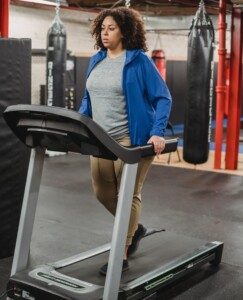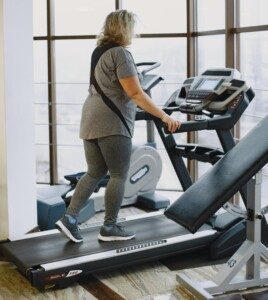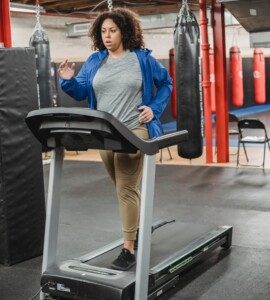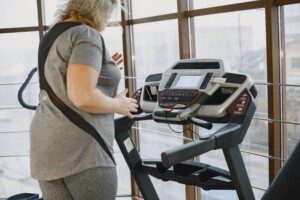Do the majority of people who hold onto a treadmill when walking have a physical disability?
Or is this merely a bad habit from ignorance?
I’m a former personal trainer who was inspired to write this article by a man’s reaction to my statement, “Most people hold onto a treadmill.”
As I proceeded to talk further about this – expressing that correct treadmill use is a very keen interest of mine – he interrupted with, “Maybe they have a disability.”
The irony is that this man was not a gym user. Nor was he a treadmill user. Fact is, he hardly exercised.
Yet he jumped in with the assumption that most people who hold onto a treadmill have a disability of some sort.
If most people, who hold onto a treadmill, have a medical condition that impairs their mobility, then we have to assume several things.
• By very odd chance, many of those disabled people are in their 20s and 30s.
• Whatever their condition is, doesn’t impede their ability to walk up a staircase without holding onto the rails, squat with a bar across their back or while holding dumbbells or to do walking lunges. Yes, I’ve seen them do these things.
• A significant percentage of gym patrons – at any gym anywhere – have a medical condition that impairs walking.
The three bullet points above are simply not believable.
I’ve been using gyms for many years – and many different gyms because I’ve belonged to chain gyms.
And I’ve seen the same thing over and over and over: At least half the people on a treadmill, at any given time, are holding on.

Fake walking; note unnatural shoulder and arm positions. Julia Larson/Pexels
Furthermore, many are visibly in their 20s and 30s. Most are not morbidly obese.
In fact, I’ve seen morbidly obese people walking on a treadmill without holding on. I’ve also seen elderly people using a treadmill without holding on.
But overall, across all age brackets and across all “body types,” many men and women hold onto a treadmill.
This has nothing to do with a disabling medical condition or impaired vision.
Not only does the evidence for this harken back to those three bullet points, but I have actually spoken to countless people regarding their habit of holding on.
I spoke to them before I became a personal trainer — at many different gyms including one on a cruise ship while on vacation — and of course, while I was a personal trainer.
In fact, while I was employed at the large, crowded health club, I gave myself a daily quota: Speak to two to three people who were holding onto a treadmill.

Note the forward lean. Gustavo Fring/Pexels
The most common reasons they gave me for holding onto the treadmill were as follows:
- Not knowing it was counterproductive; the rails were there.
- Believing that was the proper way to use the machine.
- Everyone else was doing it.
- Fear of falling off.
- Not being able to keep up with the tread.
- Getting dizzy if they let go.
- The heart rate monitor keeps saying to keep holding on.
It was actually very rare for someone to cite a medical condition. Only one person said they had multiple sclerosis.
Another said he had a recent hip replacement. Another said she had osteoarthritis in her knees.
But as for the seven bullet-point explanations listed above, you may think that those are legitimate reasons.
If a person wants results from their exercise, they need to do it correctly.

The arms and shoulders are moving naturally. Julia Larson/Pexels
I’m all for holding onto a treadmill on a momentary basis – such as when sipping a beverage or turning to talk to someone.
But the entire time? This will sabotage the pursuit of reaching one’s fitness or weight loss goals.
Let’s crack open those seven reasons for holding onto a treadmill!
#1 The rails are there. Well of course they’re there – so that the product can have mass appeal to even the most skittish user, and to also protect the manufacturer from lawsuits in case someone falls off.
#2 Believing it’s the right thing to do. For many, they just do not realize that holding on is counterproductive, alters natural gait, can lead to repetitive stress injuries in the hips and shoulders, burns far fewer calories (never mind the calorie display; it would show even if you stepped off the machine!), and teaches the body to become less efficient at balance.
#3 “Everyone else does it.” No joke; I’ve gotten this precise response. Many people are followers.
If everyone else is doing something a certain way, they’ll do it that way too. But popularity doesn’t mean efficiency.
#4 Fear of falling off. While this sounds like a smart reason to hold on, you must ask yourself if there’s a more intelligent way to correct this problem.
How about REDUCING the speed or LOWERING the incline?
#5 Not being able to keep up with the tread. The correction for this is the same as for #4.
People will have the speed at 4 mph, incline at 15%, and tell me they can’t keep up without holding on.
Well of course you can’t keep up! A sustained 4 mph walk at 15% incline without holding on requires tremendous fitness to pull off. These settings are totally unrealistic to maintain.
#6 Getting dizzy if they let go. This simply means their body isn’t used to walking on a moving tread.
Every single person who reported this corrected the problem by committing to walking hands-free – and for some, the dizziness vanished after only a few minutes – once their body figured out what was happening.

Her spine is much straighter. Julia Larson/Pexels
#7 Heart rate monitor keeps flashing, “Keep your hands on the sensors.”
Humans should not be taking orders from machines. When it’s time to check your heart rate, hold on. After you get the reading, let go.
If the machine keeps telling you to hold on, IGNORE IT.
As for the woman who had osteoarthritis in her knees, she was obese and in her 50s – and my client.
I instructed her to let go, starting with a slow speed. Over the ensuing weeks, her loppy gait – both on and off the treadmill – visibly improved!
To say that people who hold onto a treadmill are necessarily disabled is kind of like saying people who bring the bar down only halfway for the bench press are disabled. Come on.
As for the man at the top of this article — he’s doing what I call the “light gravity walk.” The notable forward lean also removes workload from his core and hips.
 Lorra Garrick is a former personal trainer certified by the American Council on Exercise. At Bally Total Fitness she trained clients of all ages for fat loss, muscle building, fitness and improved health.
Lorra Garrick is a former personal trainer certified by the American Council on Exercise. At Bally Total Fitness she trained clients of all ages for fat loss, muscle building, fitness and improved health.
.








































